AUDI A8 2017 Owners Manual
Manufacturer: AUDI, Model Year: 2017, Model line: A8, Model: AUDI A8 2017Pages: 354, PDF Size: 88.68 MB
Page 91 of 354
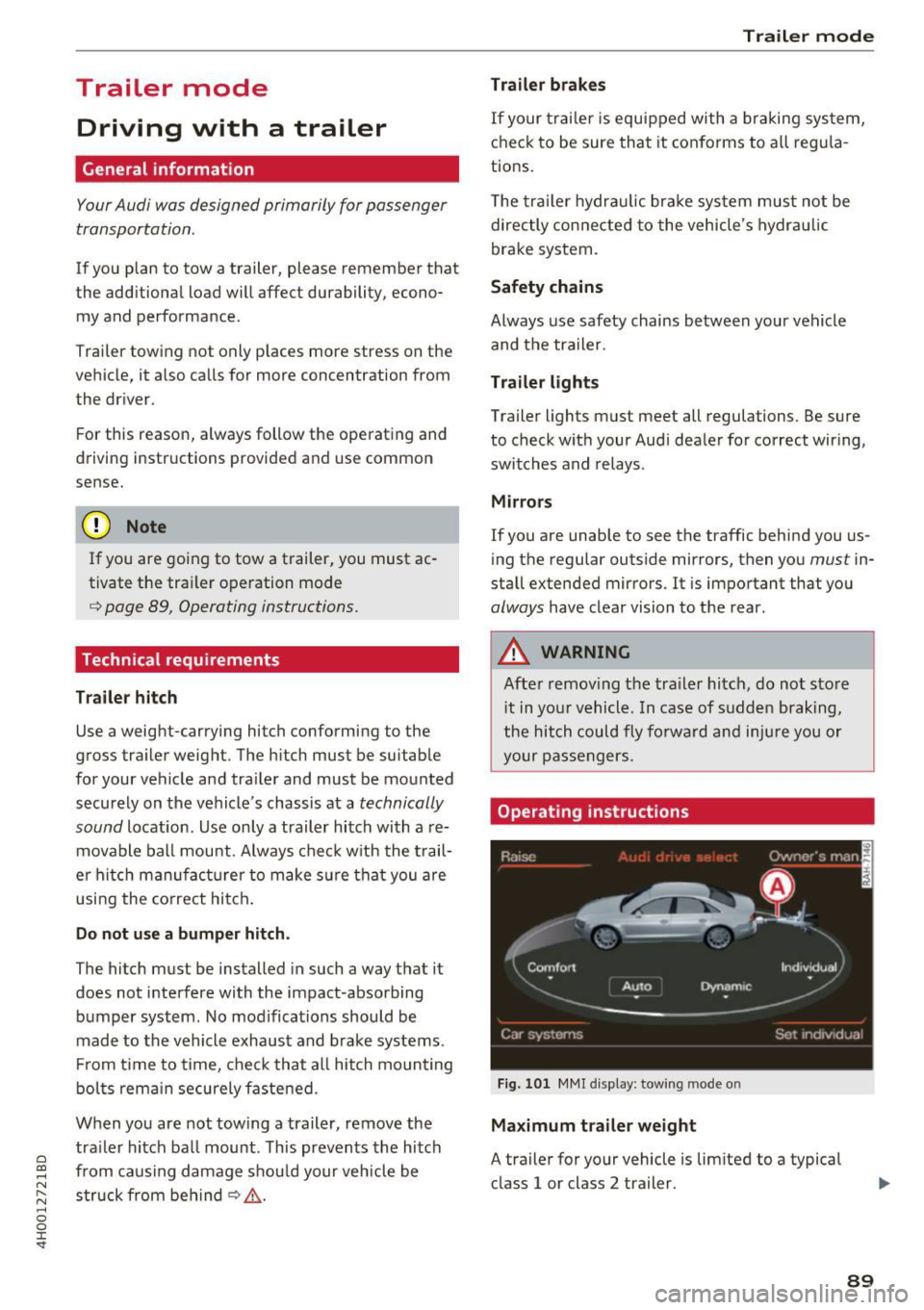
C) C0 ....
"' " "' .... 0 0 :r
Gen eral information
Your Audi was designed primarily for passenger
transportation .
If you plan to tow a trailer, please remember that
the additional load will affect durability, econo
my and performance .
T ra iler towing not only p laces more stress on the
vehicle, it a lso calls for more concentration from
the driver.
For this reason, always follow the operating and
driving instr uctions provided and use common
sense.
(D Note
If you are going to tow a trailer, you must ac
tivate the tra iler operation mode
<=> page 89, Operating instructions.
Technical requirements
Tr ailer hitch
Use a weight-carrying hitch conforming to the
gross tra iler weight. The h itch must be suitab le
for your vehicle and tra iler and must be mounted
securely on the vehicle's chassis at a
technically
sound
location . Use on ly a trailer hitch with a re
movable ba ll mount . Always chec k w ith the t rail
er hitch manufac turer to make sure that you are
using the correct hitch .
Do not u se a bumper hitch .
The hitch must be installed in such a way that it
does not interfere with the impact -absorbing
bumper system . No mod ifications should be
made to the vehicle exhaust and b rake systems .
Fr om t ime to t ime, check that al l hitch mo un ting
bol ts rem ain securely fastened.
When you are not towing a trailer, remove the tra iler hi tch ba ll mount . This preven ts the hitch
from causing damage shou ld your vehicle be
struck from beh ind
C? _&. .
Tr ailer mod e
Trailer brakes
If your trai ler is equ ipped with a b raking system,
check to be sure that it conforms to a ll regu la
tions.
T he trai ler hydra ulic bra ke sys tem must not be
directly connected to the vehicle's hydra ulic
brake system.
Safety chains
Always use safety chains between your vehicle and the tra iler .
Tra iler lights
Trailer lights must meet all regulations. Be sure
to check w ith your Audi dealer for correct wir ing,
switches and relays .
Mirror s
If you are unable to see the traffic behind you us
ing the regular outside mirrors, then you
must in
stall extended mirrors . It is important that you
always have clear vision to the rear .
A WARNING ,~ -Afte r remov ing the tra ile r hitch, do not sto re
i t in you r vehicle. In case of sudden brak ing,
t he hitch could fly fo rward and inju re you or
your passengers.
Operating instruction s
Fig. 10 1 M MI displ ay: towing mode o n
Maximum tra iler weight
A trailer for your vehicle is lim ited to a typical
class 1 or class 2 trailer.
89
Page 92 of 354

Trailer mode
Trailer load distribution
Be s ure the load in the trailer is held securely in
p lace to prevent it from shifting forward, back
ward or sideways .
Never allow a passenger to ride in a trailer¢.&.
in Driving instructions on page 91.
Engine cooling system
Towing a trailer makes the eng ine work harder . It
is important that the cooling system's perform
ance is up to the additional load. Make sure that
the cooling system has eno ugh fluid.
Tire pressure
When tow ing a tra iler, inflate the tires of your
veh icle to the tire pressure listed under "Full
load " on the label ¢
page 293 . Inflate trailer
tires to trailer and tir e manufacturers' specifica
tions.
Lights
Check to make sure both vehicle and trailer lights
are working properly .
Safety chains
Be sure trailer safety chains are properly connect
ed from the trailer to the hitch on the vehicle. Leave enough slack in the chains to permit turn
ing corners . When you install safety cha ins, make
sure they w ill not drag on the road when you are
driving.
The chains should cross under the trailer tongue to prevent it from dropping in case of separation
from the hitch.
Adjusting the Audi drive select
Make sure the vehicle is on a level surface before
hitching up the trailer and before adjust ing the
tongue weight. The vehicle must be in
auto or
comfort driving mode and not raised
o:,;, page 110, o:,;, 0 .
Make sure that the vehicle is lowered. In Info
tainment, select:
ICARI function button> Lower
control button.
90
If you must drive under poor road conditions, you
can raise the vehicle
after coupling the trailer or
after adjust ing the tongue we ight ¢ page 112.
([) Note
-Changes in temperature or load can affect
the height of the vehicle.
- Always select auto or comfort mode. Other
wise, the tongue load specified for your ve
hicle will no longer be app licab le .
Driving instructions
Driving with a trailer always requires extra care
and consideration.
Weight distribution
Towing a loaded trailer with an empty car results
i n a high ly unstable distribution of we ight . If this
cannot be avoided, drive at very low speeds only
to avoid t he risk of losing steering contro l.
A "balanced " rig is easier to operate and control.
This means that the tow vehicle should be loaded
to the extent possible and permissib le, wh ile
keeping the trailer as light as possible under the
circumstances. Whenever possible, transfer
some cargo to the luggage compartment of the
tow veh icle while observing tongue load require
ments and vehicle loading considerations.
Speed
The higher the speed, the more difficult it be
comes for the driver to control the rig . Do not
drive at the maximum permissible speed. Reduce
your speed even more if load, weather or wind cond it ions are unfavorable - particularly when
go ing downh ill.
Reduce vehicle speed
immediately if the trailer
shows the slightest sign of sway ing.
Do not try
to stop the swaying by accelerating.
Observe speed limits. In some areas, speeds for
vehicles towing trailers are lower than for regular
vehicles.
Always apply brakes early. When driving down
hill, shift into a lower gear to use the engine
braking effect to slow the vehicle. Use of the
brakes alone can cause them to overheat and fail. ..,.
Page 93 of 354

0 co .... N ,..._
N .... 0 0 :c '
When driv ing with a trailer, activate the trailer
mode of the air suspension. Switch the air sus
pension trailer mode on when you are towing a
trailer. This will limit the regulation by the air
suspension while driving. Select in the MMI:
ICARI function button > (Ca r)* systems control
button
> Vehicle settings > Air susp.: towing >
On.
Coolant temperature
The coolant temperature gauge¢ page 9 must
be observed carefully . The coolant temperature
can increase if you drive on long inclines in a low
gear at high engine speeds. Reduce your speed
i mmed iately if the LEDs in the top part of the dis
p lay turn on.
For more information about indicator lights, re
fer to. ¢
page 20.
A WARNING
Anyone not properly restrained in a moving
vehicle is at a much greater risk in an acci
de nt. Never let anyone ride in you r car who is
not properly wearing the restraints p rovided
by Audi.
Trailer mode notes
Important to know -
Your veh
icle handles differently when tow ing a
tra iler because of the additional weight and d if
ferent weight distr ibut ion. Safety, performance
and economy will greatly depend on how careful
ly yo u load you r trailer and operate your rig.
Before you actually tow your trailer, practice
turning, stopp ing and back ing up in a n area away
from traffic. Keep practicing until you have be
come completely fami liar with the way your vehi
cle-trailer comb inat io n behaves and responds.
Backing up is difficult and requires pract ice.
Backing up with a trailer gene rally requires steer
ing action opposite to tha t when backing up your
ve hicl e without a trailer .
Maintain a greater d istance between your vehicle
and the one in front of you . You w ill need more
Trailer mode
room to stop . To compensate for the trailer, you
will need a larger than normal turning radius .
When passing, remember that you cannot accel
erate as fast as you normally wo uld because of
the added load. Make sure you have enough room
to pass. After passing, allow p lenty of room for
your trailer before changing lanes again .
Avo id jerky starts, sharp turns or rapid lane
changes.
(D Tips
- Do not tow a trailer during the break-in peri
od of your veh icle.
-If you tow a trailer, your Audi may requ ire
more frequent maintenance due to the ex
tra load ¢
page 336.
Parking on a slope
Do not park on a slope with a trailer. If it cannot
be avoided, do so only after doing the following:
When parking:
" Apply the foot brake .
" Have someone place chocks under both the ve
hicle and the trailer wheels.
"W ith chocks in place, slowly release the brakes
until the wheel chocks absorb the load.
" Tur n the whee ls towards the curb.
" App ly the parking brake.
" Select the P selector lever position.
When restarting after parking:
"App ly the foot brake.
" Start the engine .
"S elect the D selector lever position .
" Release the parking brake and slowly pull out
and away from the wheel chocks.
" Stop and have someone retrieve the wheel
chocks.
(D Tips
If you move the selector lever of the automat
i c transmission to P before applying the park
in g brake and before blocking the wheels, you
may have to use more force later to move the
lever out of the P posit ion.
91
Page 94 of 354

Ass is t
Assist
Speed warning system
The speed warning system helps you to stay un
der a specified maximum speed.
The speed warning system warns you if you are
exceeding the maximum speed that you have set.
A warning tone will sound as soon as your speed
exceeds the stored value slightly.
The . (USA models)
I. (Canada models) indi
cator light and a message appear in the instru
ment cluster display at the same time. The./
• indicator light and the message turn off if the
speed falls back below the stored maximum
speed.
Setting a threshold is recommended if you would
like to be reminded when you reach a certain
maximum speed. Situations where you may want
to do so include driving in a country with a ge ner
al speed limit or if the re is a specified max imum
speed for winter tires.
Setting the warning threshold
The warning threshold is set in the Infotainment
system .
.,. Se lect :
!CAR I function button > Car s ystems
control button > Dri ver assi st > Speed warning .
(D Tips
Regardless of the speed wa rning system, you
should always monitor yo ur speed using the
speedometer and make sure you are following
the legal speed limit.
92
Cruise control system
Switching on
The cruise control system makes it possible to
drive at a constant speed starting at 20 mph (30
km/h) .
0
f
®l
0
Fig. 102 Ope rat ing leve r: cru ise co ntrol sys tem
g M 0 ±
~
.,. To switch the cr uise control on, pull the lever
into position
(D ¢ fig . 102.
.,. Drive at the speed to be maintained.
.,. To store the speed, press the button @.
The stored speed and the
[t!jl!)~i~ (USA models) I
&I (Canada models) ind icator light are d isp layed
in the instrument cluster.
This information is also shown briefly in the Head-up d isp lay* .
The speed is mainta ined by modifying engine
power or through a n active brake interven tion.
_& WARNING
-Always pay atten tion to the traffic around
you when the cruise contro l system is in op
erat ion. You are always respons ible for your
speed and the distance between your ve hi
cle and other vehicles.
- For safety reasons, cruise control should not
be used in the city, in stop-and-go traff ic, on
w inding roads and when road conditions are
poor (such as ice, fog, gravel, heavy rain and
hydroplaning), because this increases the
r is k of an a ccident.
- Switch t he cruise control off temporarily
when dr iving in turning lanes, highway exits
or in construction zones.
...
Page 95 of 354
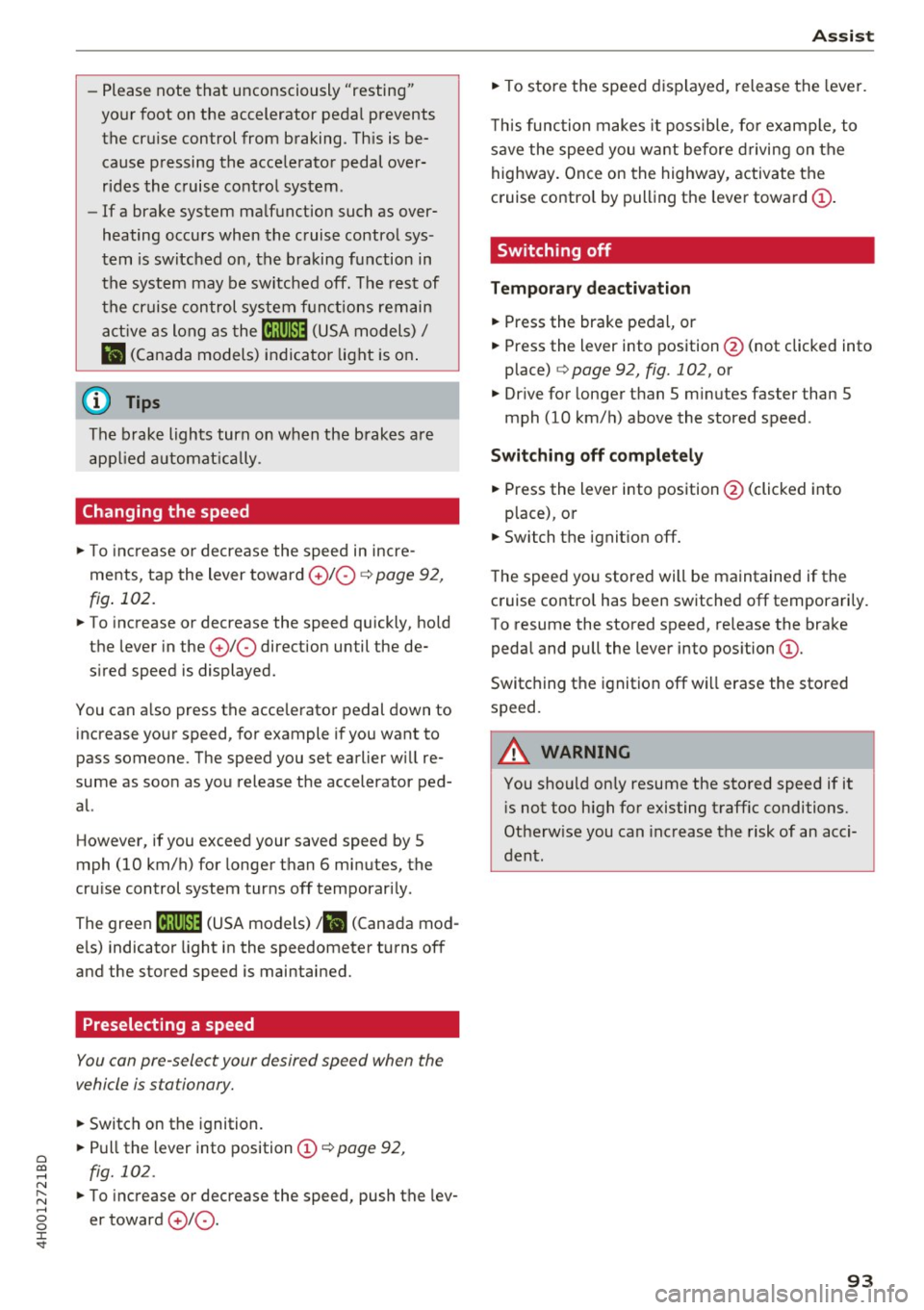
0 co .... N ,..... N .... 0 0 :c '
your foot on the accelerator pedal prevents
the cruise control from braking. This is be
cause pressing the accelerator pedal over
rides the cruise control system .
- If a brake system malfunction such as over
heating occurs when the cruise control sys
tem is switched on, the braking function in
the system may be switched off. The rest of
the cruise control system functions remain
active as long as the
(tj;(IM@ (USA models) /
ii (Canada models) indicator light is on.
@ Tips
The brake lights turn on when the brakes are
applied automat ically .
Changing the speed
.. To increase or decrease the speed in incre
ments, tap the lever toward
010 q page 92,
fig . 102.
.. To increase or decrease the speed quickly, hold
the lever in the
010 direction until the de
sired speed is displayed.
You can a lso press the accelerator pedal down to
increase your speed, for example if you want to
pass someone. The speed you set earlier will re
sume as soon as you release the accelerator ped
al.
However, if you exceed your saved speed by 5
mph (10 km/h) for longer than 6 minutes, the
cru ise control system turns off temporarily .
The green
ltj;(i )~i@ (USA models) 1 '11 (Canada mod
els) indicator light in the speedometer turns off
and the stored speed is maintained.
Preselecting a speed
You can pre-select your desired speed when the
vehicle is stationary.
.. Switch on the ignition .
.. Pull the lever into position
(D q page 92,
fig. 102.
.. To increase or decrease the speed, push the lev
er toward
010 .
Assist
.. To store the speed displayed, release the lever.
T his function makes it possible, for example , to
save the speed you want before driving on the
highway. Once on the highway , activate the
cruise control by pulling the lever toward @.
Switching off
Temporary deactivation
.. Press the brake pedal, or
.. Press the lever into position @ (not clicked into
place)
9 page 92, fig. 102, or
.. Drive for longer than S minutes faster than 5
mph (10 km/h) above the stored speed .
Switching off completely
.. Press the lever into position @(clicked into
place), or
.. Switch the ignition off .
The speed you stored will be maintained if the
cruise contro l has been switched off temporarily .
To resume the stored speed, release the brake
pedal and pull the lever into posi tion (D .
Switching the ignition off will erase the stored
speed.
A WARNING
- -
You should only resume the stored speed if it
is not too high for existing traffic conditions.
Otherw ise you can increase the risk of an acci
dent .
93
Page 96 of 354
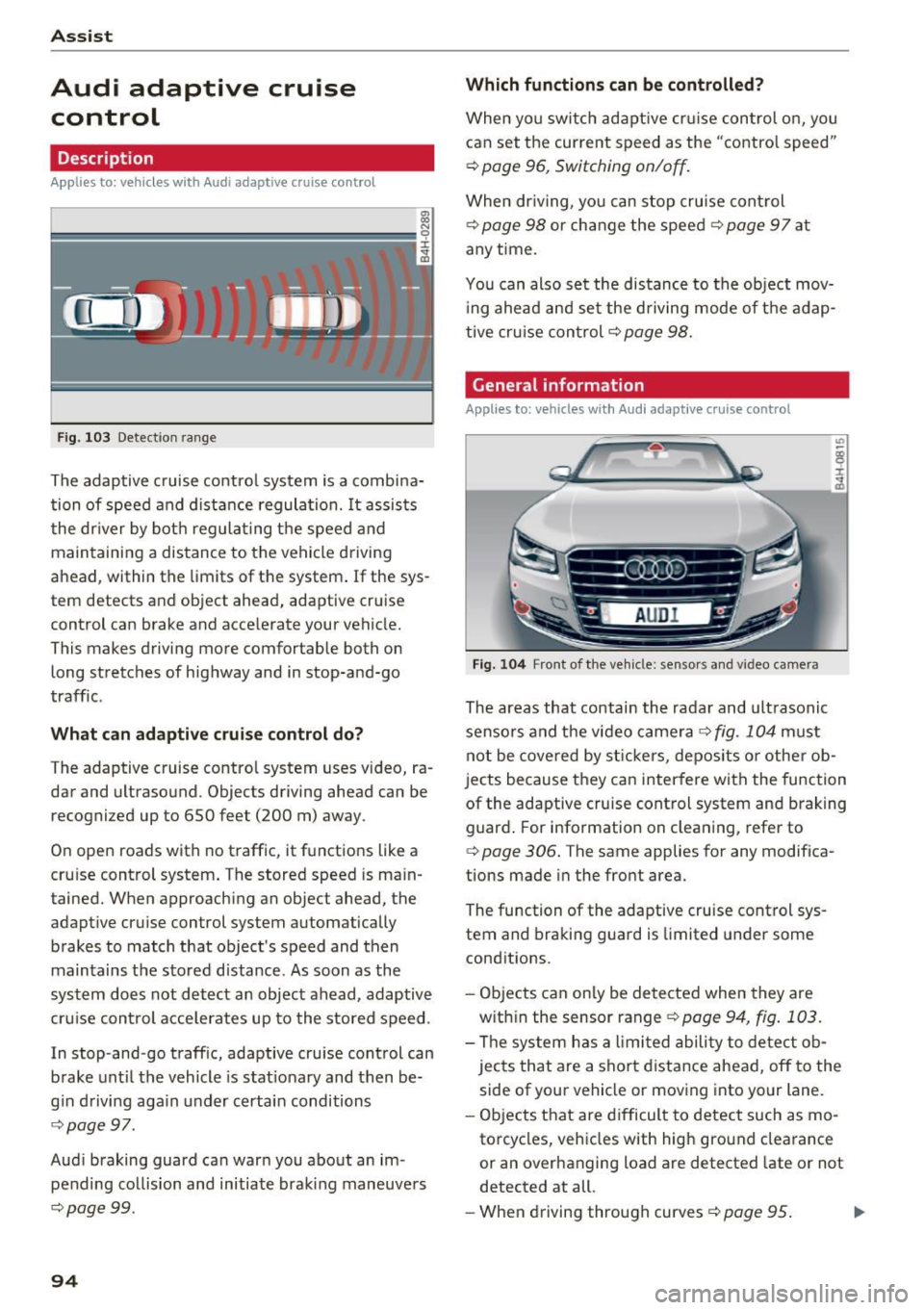
Assist
Audi adaptive cruise
control
Description
Applies to: vehicles with Audi adapt ive cruise control
F ig. 103 Detection range
The adaptive cruise control system is a combina
tion of speed and distance regulation. It assists
the driver by both regulating the speed and
maintaining a distance to the vehicle driving
ahead, within the limits of the system .
If the sys
tem detects and object ahead, adaptive cruise
control can brake and acce lerate your vehicle.
This makes driving more comfortable both on long stretches of highway and in stop-and-go
traffic .
What can adaptive cruise control do?
The adaptive cruise control system uses video, ra
dar and ultrasound . Objects driving ahead can be
recognized up to 650 feet (200 m) away.
On open roads with no traffic, it functions like a
cruise control system . The stored speed is main
tained. When approaching an object ahead, the
adaptive cruise control system automatically
brakes to match that object's speed and then
maintains the stored distance . As soon as the
system does not detect an object ahead, adaptive
cruise control accelerates up to the stored speed .
In stop-and -go traffic, adaptive cruise control can
brake until the vehicle is stat ionary and then be·
gin driving again under certain conditions
¢page 97.
Audi braking guard can warn you about an im
pending collision and initiate braking maneuvers
¢ page 99.
94
Which functions can be controlled?
When yo u switch adaptive cruise control on, you
can set the current speed as the "contro l speed"
¢ page 96, Switching on/off.
When driving, you can stop cruise control
¢page 98 or change the speed ¢page 97 at
any time.
You can also set the distance to the object mov
i ng ahead and set the driving mode of the adap
tive cruise control¢
page 98.
General information
Applies to: vehicles with Audi adaptive cruise control
Fig. 104 Front of the vehicle: sensors and video came ra
The areas that contain the radar and ultrasonic
sensors and the video camera ¢
fig. 104 must
not be covered by stickers, deposits o r other ob
jects because they can interfere with the function
of the adaptive cruise control system and braking guard . For information on clean ing, refer to
¢
page 306. The same applies for any modifica
tions made in the front area.
The function of the adaptive cruise control sys
tem and braking guard is limited under some
conditions.
- Objects can only be detected when they are
with in the sensor range
¢page 94, fig. 103.
-The system has a limited ability to detect ob
jects that are a sho rt distance ahead, off to the
side of your vehicle or moving into your lane.
- Objects that are difficult to detect such as mo
torcycles, vehicles with high ground clearance
or an overhanging load are detected late or not
detected at all.
- When driving through curves ¢
page 95. ll>
Page 97 of 354
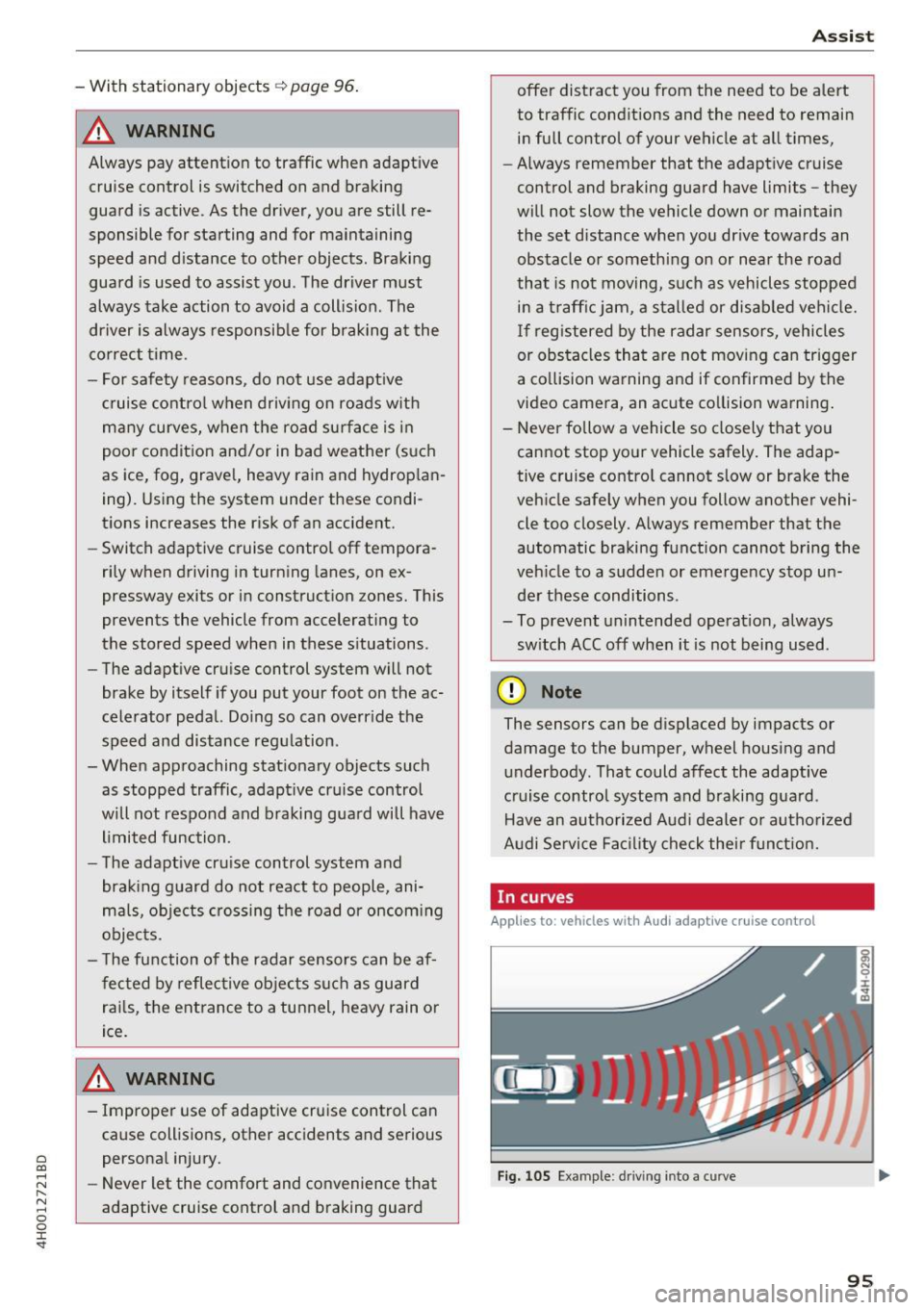
C) C0 ....
"' " "' .... 0 0 :r
A WARNING
Always pay attention to traffic when adapt ive
cruise control is switched on and braking
guard is active . As the dr iver, you are still re
sponsible for starting and for maintaining
speed and d istance to other objects. Braking
guard is used to assist you . The driver must
always take action to avoid a collision . The
driver is always responsib le for brak ing at the
co rrect time .
- For safety reasons, do not use adapt ive
cruise co ntro l when driv ing on ro ads w ith
many curves, when the road su rface is in
poor condit ion and/or in bad weather (s uch
as ice, fog, grave l, heavy rain and hydrop la n
ing). Using the system under these condi
t ions increases the risk of an accident.
- Switch adaptive cruise contro l off tempora
rily when driving in turning lanes, on ex
pressway exits or in construction zones. This
prevents the vehicle from accelerating to
the stored speed when in these situations .
- The adapt ive cru ise control system will not
brake by itself if you put your foot on the ac
celerator pedal. Doing so can overr ide the
speed and distance regulation .
- When approaching stat ionary objects such
as stopped traffic, adapt ive cru ise control
will not respo nd and braking gua rd will have
l imited func tion .
- The adapt ive cru ise control system and
bra king g uard do not react to people, ani
mals, objects crossing the road or oncom ing
objects.
- T he function of the radar sensors can be af
fec ted by reflec tive objects s uch as guard
rai ls, the ent rance to a tunnel, heavy rain or
ice.
& WARNING
- Improper use of adaptive cruise control can cause collisions, other accidents and serious
persona l injury.
- Never let the comfort and convenience that
adaptive cruise cont rol and braking guard
A ss ist
offe r dist ract you from the need to be alert
to traffic cond itions and the need to remain
in full control of your vehicle at all times,
- Always remember that the adaptive cruise
control and braking guard have limits -they
will not slow the vehicle down or maintain
the set distance when you dr ive towa rds an
obstacle or something on or near the road
that is not moving, s uch as vehicles stopped
in a t raff ic jam, a stalled or disab led vehicle.
If r eg istered by the radar sensors, vehicles
or obsta cles that are not moving ca n trigger
a co llision wa rning and if confirmed by the
video came ra, an acute co llision wa rning .
- Never fo llow a vehicle so closely that you
cannot stop your vehicle safely . The adap
tive cruise contro l cannot slow or brake the
veh icle safely w hen you follow another vehi
cle too closely. A lways remember that the
automatic braking function cannot bring the
veh icle to a sudde n or emergency stop u n
der these conditions .
- To prevent unintended operat ion , always
sw itch ACC off when it is not being used .
(D Note
The sensors can be d isplaced by impacts or
damage to the bumper, wheel housing and
underbody. That could affect the adaptive
cruise contro l system and braking gua rd .
Have an au thorized Audi dealer o r autho rized
A udi Service Fac ility check the ir funct ion.
In curves
Applies to: vehicles wit h Aud i ada ptive cru ise control
I
F ig. 105 Example: d rivin g i nto a c urve
95
Page 98 of 354

Ass is t
When driving into a curve ¢ fig. 105 and out of a
curve, the adaptive cruise control may react to an
object in the neighbor ing lane and apply the
brakes. You can prevent that by pressing the ac
celerator pedal brief ly .
Stationary objects
App lies to: vehicles with Audi adaptive cruise contro l
Fig . 1 06 Example: ob ject c hangin g lanes and stat ionary
object
The adaptive cruise contro l system only reacts to
objects that are mov ing or that the system has
a lready detected as movi ng. For examp le, it can
react when a vehicle that has a lready been de
tected @turns or changes lanes, but adaptive
cru ise control does not react to a stat ionary vehi
cle @.
Switching on /off
Applies to: vehicles with Audi adaptive cruise control
Fig. 1 07 Opera ting lev er: sw itch ing on a nd o ff
96
Fig. 108 In strument cl uste r: adapt ive c ruise control
You can set any speed between 20 mph (30 km/
h) a nd 95 mph ( 150 km/h).
Ind icator lights and messages in the instrument
cluster display inform you about the current sit
uat ion and setting .
An additional indicator appears in the Head-up display* .
Switching adapti ve cruise contr ol on
.,. Pull the lever toward you into position (D
¢ fig. 107 . ACC: standby appears in the dis
play .
Saving the speed and acti vating regulation
.,. To save the current speed, press the ISETI
¢ fig . 107 button. The sto red speed is shown in
the speedomete r in the LED line @and appears
briefly in the information line@¢
fig. 108 .
.,. To act ivate the regulation w hile stationary, also
press the brake pedal.
Switching adaptiv e cruise contr ol off
.,. Push the lever away from you into position @
until it cl icks into place . The message ACC : off
appears .
@ Indicator lights
II-adap tive c ruise control is switched on. No
ob jects are detected ahead . The stored speed is
maintained.
• -An object ahead w as de tected . The adaptive
cruise contro l sys tem regu lates the speed and
distance to the object ahead and accelerates/
brakes automatically .
IJ>
Page 99 of 354
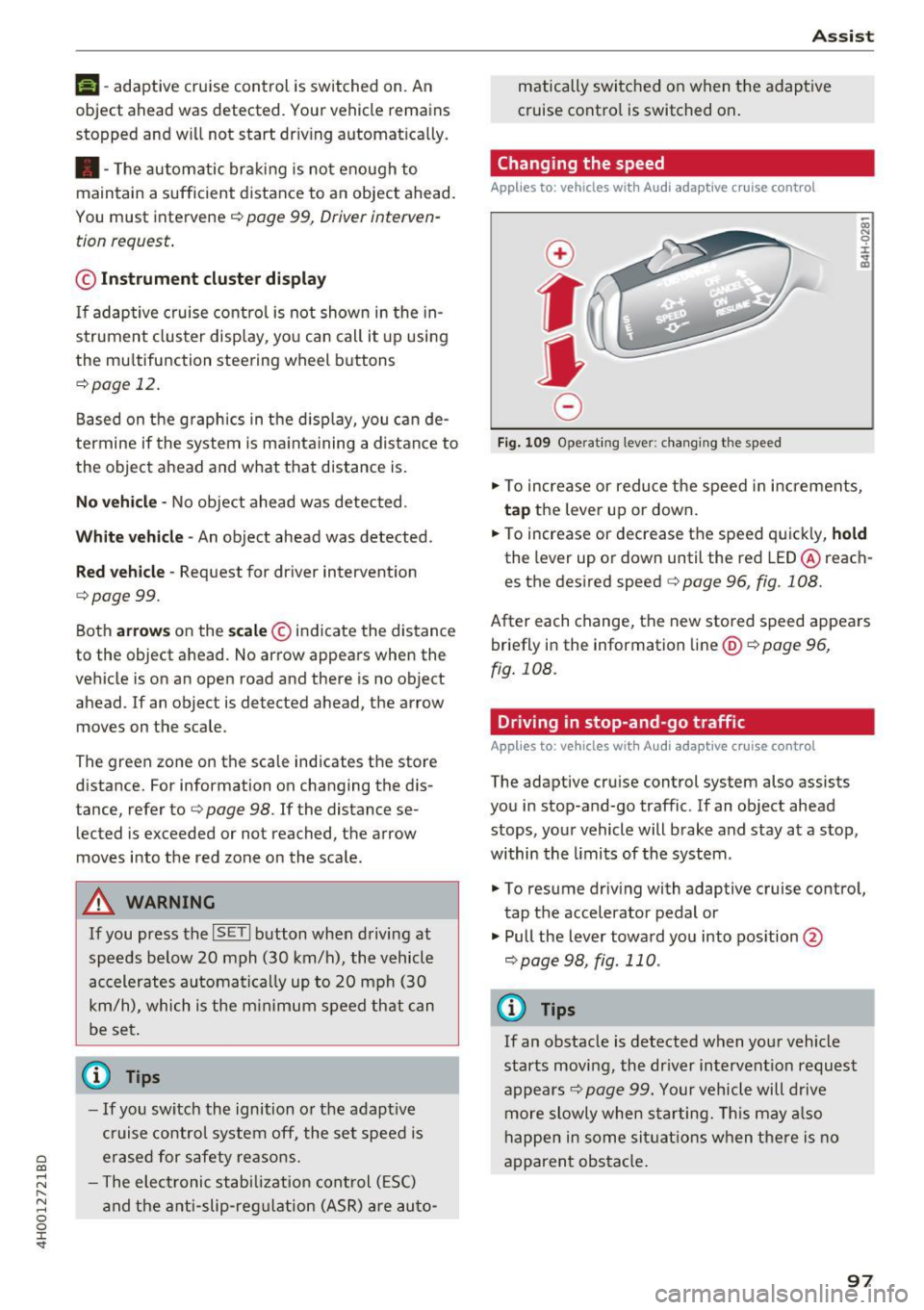
C) C0 ....
"' " "' .... 0 0 :r
object ahead was detected. Your vehicle remains
stopped and will not start dr iv ing automat ically.
• -T he automatic braking is not enough to
maintain a sufficient distance to an object ahead.
You must intervene
c:> page 99, Driver interven
tion request .
© Instrument clu ster di spla y
If adaptive cruise control is not shown in the in
strument cluster display, yo u can call it up using
the mu ltifunction stee ring wheel buttons
<=:> page 12.
Based on the graphics in the d isplay, you can de
termine if the system is ma inta ining a distance to
the object ahead and what that distance is.
No v ehi cle -No object ahead was detected.
Whit e ve hicle -An object ahead was detected .
Red vehicl e -Request for driver intervention
c:>page 99.
Both arrows on the s cale © indicate the distance
to the object ahead. No arrow appears when the
vehicle is on an open road and there is no object
ahead. If an object is detected ahead, the arrow
moves on the scale.
The green zone on the scale indicates the store
distance. For information on changing the dis
tance, refer to
c:> page 98. If the distance se
lected is exceeded or not reached, the arrow
moves into the red zone on the scale.
A WARNING
~=-:---
If you press the ISETI b utton when driving at
speeds be low 20 mph (30 km/h), the vehicle
accelerates automatica lly up to 20 mph (30
km/h), which is the m in imum speed that can
be set .
(D Tips
-If you switch the ignition o r the adapt ive
cruise contro l system off, the set speed is
erased for safety reasons.
- The elect ronic stab ilization cont rol (ESC)
and the a nti -slip-reg ulation (ASR) a re au to-
A ss ist
matically switched on when the adaptive
cruise control is switched on .
Changing the speed
Applies to: vehicles with Audi adaptive cruise control
0
f
•
0
Fig . 1 09 Operat ing lever : c h an gi ng the speed
co N 0 :i: ~ m
.. To increase or reduce the speed in increments,
ta p the lever up or down .
.. To increase or decrease the speed quickly,
h o ld
the lever up or down until the red LED@reach
es the desired speed
c:> page 96, fig. 108.
After each change, the new stored speed appears
briefly in the information line@
c:> page 96,
fig. 108.
Driving in stop-and-go traffic
Applies to: vehicles with Audi adaptive cruise control
The adaptive cruise control system also assists
you in stop-and-go traffic . If an ob ject ahead
stops, your vehicle will brake and stay at a stop,
within the limits of the system.
.. To resume driving with adaptive cruise control,
tap the accelerator pedal or
.,. Pull the lever toward you into pos ition @
c:> page 98, fig . 110 .
a) Tips
If an obstacle is detected when your vehicle
starts moving, the dr iver intervent ion request
appears
c:> page 99. Your vehicle will drive
more slowly when starting. This may a lso
happen in some si tuatio ns when the re is no
apparent obstacle .
97
Page 100 of 354
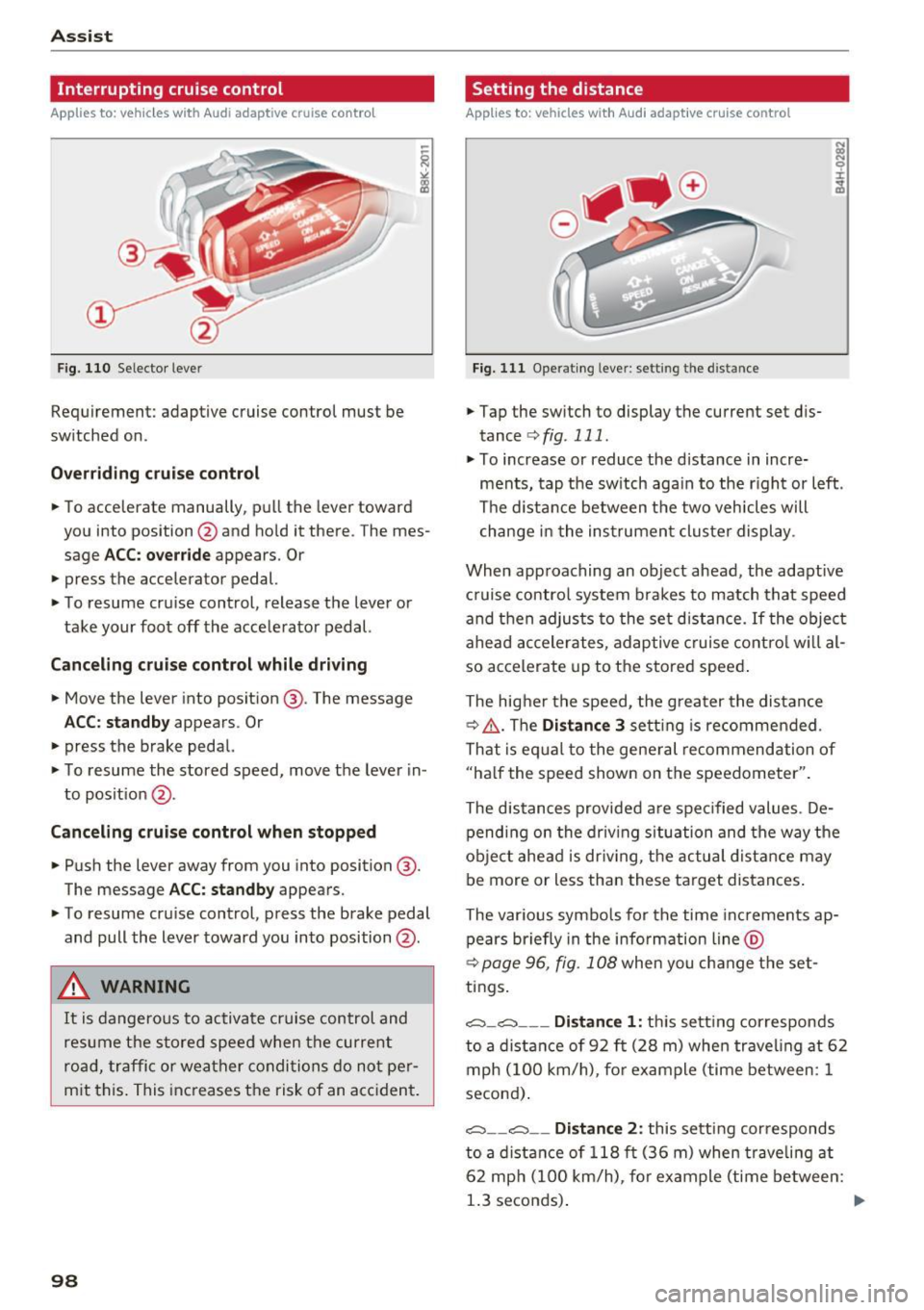
Assist Interrupting cruise control
Applies to: vehicles with Audi adaptive cruise contro l
Fig. 110 Selector leve r
Requirement: adaptive cruise control mus t be
sw itched on .
Overriding cruise control
• To accelerate manually , pull the lever toward
you into position @and hold it there . T he mes
sage
ACC: override appears . Or
• press the accelera tor pedal.
• To resume cruise control , release the lever or
take your foot off the accelerator pedal.
Canceling cruise control while driving
• Move the lever into position @. The message
ACC: standby appears . Or
• press the brake pedal.
• To resume the stored speed, move the lever in
to posit ion @.
Canceling cruise control when stopped
• Push the lever away from you into position @.
The message
ACC : standby appears.
• To resume cruise control, press the brake pedal
and pull the lever toward you into position @.
.&, WARNING
It is dangerous to activate cruise control and
resume the stored speed when the current
road, traffic or weather conditions do not per
mit this. This increases the risk of an accident.
98
Setting the distance
Applies to: vehicles with Audi adaptive cruise control
Fig. 111 Ope rating leve r: sett ing th e dis tan ce
• Tap the switch to display the current set dis
tance
¢ fig . 111 .
• To increase or reduce the distance in incre
ments, tap the switch again to the right or left .
The distance between the two veh icles will
change in the instrument cluster display .
When approaching an object ahead, the adaptive
cruise contro l system brakes to match that speed
and then adjusts to the set distance.
If the object
ahead accelerates, adaptive cruise control will al
so accelerate up to the stored speed .
The higher the speed, the greater the distance
¢ ,&. .The
Distance 3 setting is recommended .
That is equal to the general recommendation of
"half the speed shown on the speedometer".
The distances provided are spec ified values . De
pending on the driving situation and the way the
object ahead is dr iving, the actual distance may
be more or less than these target distances .
The var ious symbo ls for the time increments ap
pears briefly in the information line @
¢
page 96 , fig . 108 when you change the set
tings .
c::::,_c::::, ___ Distance 1 : this setting corresponds
to a distance of 92 ft (28 m) when traveling at 62
mph (100 km/h), for example (time between: 1
second) .
c::::, __ c::::, __ Distance 2: this setting cor responds
to a distance of 118 ft (36 m) when traveling at
62 mph (100 km/h) , for example (time between:
1.3 seconds) . ""